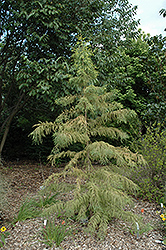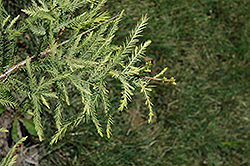Height: 20 feet
Spread: 10 feet
Sunlight:
![]()
Hardiness Zone: 5a
Description:
A compact narrowly pyramidal deciduous conifer native to the Great Lakes and quite hardy; narrow yellow leaves turn a rusty brown in fall, a wonderful color accent tree for a smaller landscape
Ornamental Features
Peve Yellow Baldcypress is primarily valued in the landscape for its rigidly columnar form. It has attractive chartreuse deciduous foliage which emerges buttery yellow in spring. The ferny bipinnately compound leaves are highly ornamental and turn an outstanding coppery-bronze in the fall. The shaggy antique red bark adds an interesting dimension to the landscape.
Landscape Attributes
Peve Yellow Baldcypress is a deciduous tree with a strong central leader and a narrowly upright and columnar growth habit. It lends an extremely fine and delicate texture to the landscape composition which can make it a great accent feature on this basis alone.
This is a relatively low maintenance tree, and is best pruned in late winter once the threat of extreme cold has passed. Deer don't particularly care for this plant and will usually leave it alone in favor of tastier treats. It has no significant negative characteristics.
Peve Yellow Baldcypress is recommended for the following landscape applications;
- Shade
- Vertical Accent
Planting & Growing
Peve Yellow Baldcypress will grow to be about 20 feet tall at maturity, with a spread of 10 feet. It has a low canopy with a typical clearance of 3 feet from the ground, and is suitable for planting under power lines. It grows at a slow rate, and under ideal conditions can be expected to live for 80 years or more.
This tree should only be grown in full sunlight. It is an amazingly adaptable plant, tolerating both dry conditions and even some standing water. It is not particular as to soil type, but has a definite preference for acidic soils, and is subject to chlorosis (yellowing) of the foliage in alkaline soils. It is somewhat tolerant of urban pollution. Consider applying a thick mulch around the root zone in winter to protect it in exposed locations or colder microclimates. This is a selection of a native North American species.
Disclaimer - This resource is provided for informational purposes only and does NOT reflect current availability. Inventory varies seasonally, so we cannot guarantee that every plant will be in stock at all times - please contact your favourite GardenWorks location directly for current availability. It does not include our entire inventory of plants, so be sure to visit GardenWorks to see varieties that may not be represented on this list.


